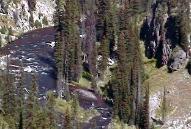The Lewis River is in the Southeast portion of the Yellowstone National Park and is a tributary of the Snake River. The Lewis River originates at the southern end of Shoshone Lake and from there it flows approximately 3 miles to Lewis Lake This portion of the river is known as the Lewis Channel and is the only portion where boating is permitted.
As noted above, the entire length of the Lewis River lies within the boundaries of the Yellowstone National Park in Wyoming. Incidently as you may have already guesses, the river is named for
Meriwether Lewis, commander of the
Lewis and Clark Expedition.
While in the 3 mile portion known as the Lewis Channel, the stream is fairly large and the brown trout are fairly large as well often averaging 15 to 20 inches.
After leaving Lewis Lake the Lewis River flows over cascades before it reaches the Bridge at the South Entrance Road. After passing the bridge, the Lewis River is smooth, slow flowing meadow water for the next 2 miles and behaves like a spring creek. Before leveling out to join the Snake River just inside the South Park Boundary, the Lewis falls into a deep canyon that is almost in accessible. For the most part, this section is not worth the effort to fish since the trout are smaller.
Fishing the Lewis River:
The fish in the Lewis Channel part the river are brown trout and brook trout with an occasional lake trout. As mentioned above the browns average from 12 to 15 inches while the brook trout are much, much smaller.
Fish in the lower portion of the river are brown trout, and cutthroat trout. In the fall, large spawning brown trout will migrate out up the Snake River and up the Lewis River to the waterfalls.
Spring:
Early spring in the pre-run-off time of the year is an excellent time to fish the Lewis River. Since the snow has not melted, the water is low, and the appetite of the trout is big causing them to be looking for food on the surface. In spring you will see the March Browns, Blue Winged Olives beatis, and the “Mother's Day” Caddis Fly hatches.
Summer:
In summer you will see hatches of Pale Morning Duns, Green Drakes, as well as several caddis species. Also, terrestrials will be a second choice.
Fall:
In the fall season, terrestrials will be a good bet especially in the meadows. Use long leaders, fine tippets, and stealth as you approach the trout. By this time of the year, these trout have become wary having seen so many attempts to trick them into a strike.






